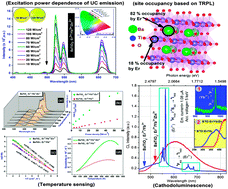Incorporation of Zn2+ ions into BaTiO3:Er3+/Yb3+ nanophosphor: an effective way to enhance upconversion, defect luminescence and temperature sensing
Abstract
Ferroelectric BaTiO3 became a multifunctional material via doping of lanthanide ions (0.3 mol% Er3+/3.0 mol% Yb3+) and subsequently upconversion luminescence was enhanced by incorporation of Zn2+ ions. Upconversion luminescence of BaTiO3:Er3+/Yb3+ perovskite nanophosphor has been studied using 800 and 980 nm laser excitations. The emission dynamics is studied with respect to its dependence on input power and external temperature including lifetime. Based on time-resolved spectroscopy, it is inferred that two types of Er3+ sites are present in the barium titanate lattice. The first one is a short lived component (minor species) present at 6-coordinated Ti-sites of low symmetry while the second one is a long lived component (major species), present at 12-coordinated Ba-sites with high symmetry. The influence of the introduction of Zn2+ ions on the lifetime of 4S3/2 and 4F9/2 levels of Er3+ ions is also investigated. Enhanced temperature sensing performance (120 K to 505 K) of the material is observed using the fluorescence intensity ratio technique, employing the emission from the thermally coupled, 2H11/2 and 4S3/2 energy levels of Er3+ ions. The defect luminescence of the material is also found to increase upon Zn-doping.



 Please wait while we load your content...
Please wait while we load your content...